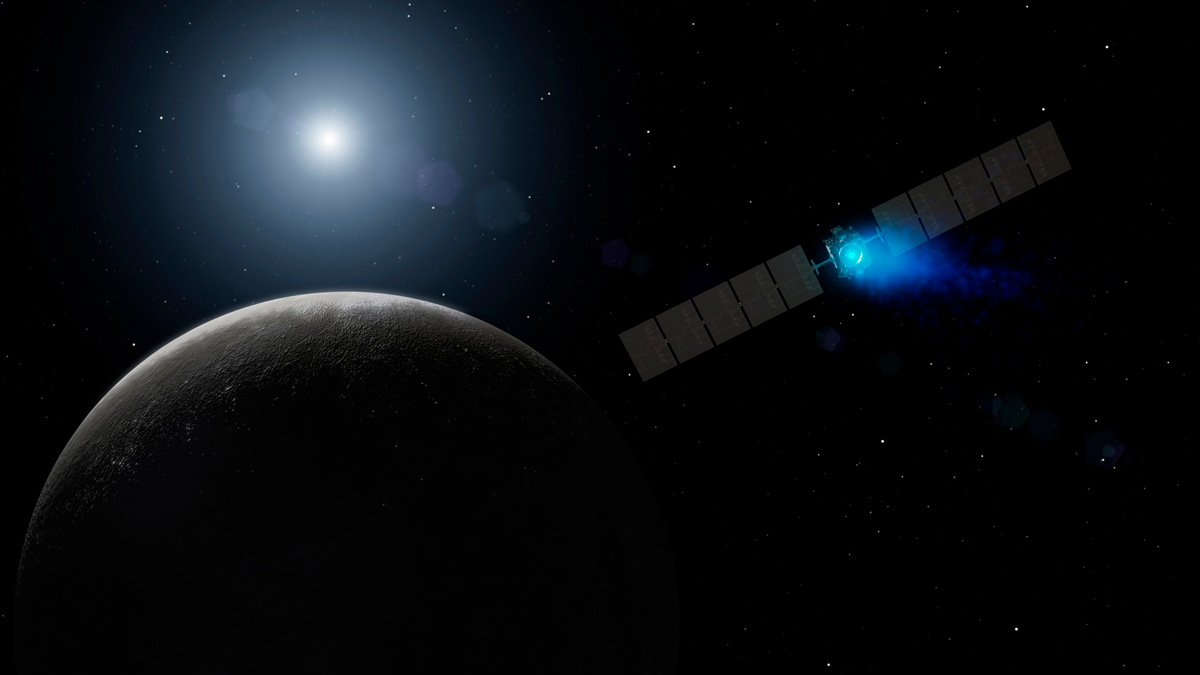
Update for March 6 at 10:09 a.m. EST: NASA's Dawn probe successfully entered orbit around the dwarf planet Ceres today at 7:39 a.m. EST (1339 GMT). Read the full story here - NASA Dawn Probe Enters Orbit Around Dwarf Planet Ceres, a Historic First
NASA's Dawn probe is just hours away from making spaceflight history.
Dawn is scheduled to slip into orbit around Ceres — the largest object in the asteroid belt between Mars and Jupiter, and Ceres — the closest dwarf planet to Earth — at about 7:20 a.m. EST (1220 GMT) on Friday (March 6).
If all goes according to plan, Dawn will become the first spacecraft ever to visit a dwarf planet, and the first to circle two different objects beyond the Earth-moon system. (Dawn orbited the protoplanet Vesta from July 2011 through September 2012.) [Dawn's Arrival at Dwarf Planet Ceres: Full Coverage]
Both Ceres and Vesta, the asteroid belt's second-largest resident, are planetary building blocks whose further growth was halted by Jupiter's gravitational influence, scientists say. So Dawn's observations should shed light on the solar system's early days and the processes that led to the formation of worlds such as Earth.
"Studying Ceres allows us to do historical research in space, opening a window into the earliest chapter in the history of our solar system," Jim Green, director of NASA’s Planetary Science Division, said in a statement. "Data returned from Dawn could contribute significant breakthroughs in our understanding of how the solar system formed."
Low-key arrival
Dawn has been using its superefficient ion engines to gradually close in on the 590-mile-wide (950 kilometers) Ceres for months. So the big moment Friday morning should be fairly low-stress for the mission team: Dawn will slide gently into orbit around the dwarf planet without any white-knuckle, make-or-break orbital-insertion burns.
Get the Space.com Newsletter
Breaking space news, the latest updates on rocket launches, skywatching events and more!
Capture by Ceres' gravity will occur at a time when Dawn is not in communication with Earth, so confirmation won't come immediately, mission team members said.
"There will be literally nothing to watch at the time that it happens, so there won't be the type of dramatic Mission Control room event that you've perhaps seen on some other missions," Dawn Project Manager Robert Mase, of NASA's Jet Propulsion Laboratory (JPL) in Pasadena, California, said during a news conference Monday (March 2).
"Around early afternoon [Friday] is when we'll get the confirmation of signal, and really that'll be the time at which we can say, indeed, capture has occurred," he added.
Much science to come
Dawn won't begin its work at Ceres on Friday morning. Rather, the probe will spend about six weeks spiraling down to its first science orbit, which Dawn should reach on April 23.
The spacecraft will then spend 16 months studying Ceres in detail from a variety of orbits, the last of which will take Dawn within just 235 miles (378 km) of the dwarf planet's surface. The mission is scheduled to end in June 2016.
The probe's extensive data sets should reveal Ceres' "shape, surface features, mineralogy and elemental composition, whether the surface is active today and how Ceres formed, so we can understand what role building blocks like Ceres had in forming our planetary neighborhood," said Dawn Deputy Principal Investigator Carol Raymond, also of JPL.
Mission scientists also hope Dawn's observations solve the mystery of Ceres' puzzling bright spots. And the spacecraft will look for signs of a water-vapor plume that was spotted recently by scientists using Europe's Herschel Space Observatory.
This plume might be a sign of icy volcanism on Ceres, researchers say. It could also have resulted when a meteorite strike exposed subsurface ice, which then sublimated off into space. (Water — mostly in the form of ice — is thought to make up 25 to 30 percent of Dawn's mass.)
"It's clear that discoveries lie ahead, and Ceres will be revealed in stunning detail, just like Vesta," Raymond said.
Follow Mike Wall on Twitter @michaeldwall and Google+. Follow us @Spacedotcom, Facebook or Google+. Originally published on Space.com.
Join our Space Forums to keep talking space on the latest missions, night sky and more! And if you have a news tip, correction or comment, let us know at: community@space.com.

Michael Wall is a Senior Space Writer with Space.com and joined the team in 2010. He primarily covers exoplanets, spaceflight and military space, but has been known to dabble in the space art beat. His book about the search for alien life, "Out There," was published on Nov. 13, 2018. Before becoming a science writer, Michael worked as a herpetologist and wildlife biologist. He has a Ph.D. in evolutionary biology from the University of Sydney, Australia, a bachelor's degree from the University of Arizona, and a graduate certificate in science writing from the University of California, Santa Cruz. To find out what his latest project is, you can follow Michael on Twitter.









